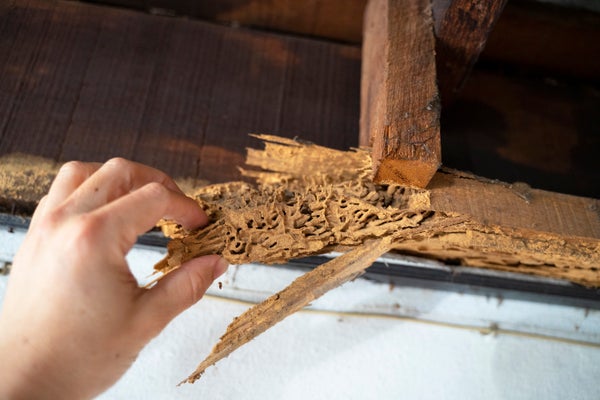As much as 85 percent of U.S. emissions of sulfuryl fluoride—a rare greenhouse gas and common pesticide used to treat termites—comes from California
Thank you for reading this post, don't forget to subscribe!By Chelsea Harvey & E&E News

Roof damaged by termites.
eyesfoto/Getty Images
CLIMATEWIRE | A little-known greenhouse gas is slowly building up in Earth’s atmosphere. And a large chunk of those emissions come from California, a state with otherwise aggressive greenhouse gas reduction targets.
That’s according to a new study that tracked U.S. emissions of sulfuryl fluoride, a pesticide commonly used to treat termites and other household insects. The colorless gas is effective at treating bugs, but it has an unintended side effect: It has a warming effect on the planet when it leaks into the atmosphere.
Studies suggest that as much as 17 percent of the world’s sulfuryl fluoride emissions may come from the U.S. And the new study, published Wednesday in the journal Communications Earth & Environment, suggests that 60 to 85 percent of those U.S. emissions are trickling out of California.
On supporting science journalism
If you’re enjoying this article, consider supporting our award-winning journalism by subscribing. By purchasing a subscription you are helping to ensure the future of impactful stories about the discoveries and ideas shaping our world today.
The study analyzed data from NOAA’s Global Greenhouse Gas Reference Network, which collects air samples from monitoring stations or aircraft around the world. The program keeps tabs on the atmospheric concentrations of dozens of different greenhouse gases, sulfuryl fluoride included.
The researchers found that the biggest sulfuryl fluoride hot spots in the United States were concentrated at just a few monitoring stations in Southern California.
Still, winds and other weather-related factors mean that emissions don’t always originate in the places they’re detected — they could have swept in from somewhere else. So the researchers further investigated using a special type of model that accounts for atmospheric circulation patterns and other factors.
The model confirmed that most emissions are coming from California, particularly Los Angeles, Orange and San Diego counties.
That’s likely because of the state’s high use of sulfuryl fluoride for fumigation purposes, the researchers suggest.
The western United States is home to a species of termite known as the western drywood termite, which can be difficult to treat. Unlike other species found elsewhere in the country, it doesn’t need plants or soil to stay alive — instead, it builds its colonies directly into high areas of wooden structures without foraging on the ground for its food. That makes fumigation more effective compared to other types of pesticide treatments, such as termite bait.
California’s own state data indicates that around 85 percent of the state’s sulfuryl fluoride use is for fumigation purposes. And state records also suggest that its use has gradually increased since at least 2007.
“For most greenhouse gases, California has been very intentional about how it’s going to reduce emissions,” said lead study author Dylan Gaeta, a researcher at Johns Hopkins University, in a statement. “This one has slipped under the radar.”
California has a statewide climate target that aims to reduce its greenhouse gas emissions by 40 percent below its 1990 levels by the year 2030. But while the state classifies sulfuryl fluoride as a climate-warming pollutant, it hasn’t yet added it to its greenhouse gas inventory or its climate change scoping plan, which lays out a pathway to achieve its climate targets.
In fact, it’s only relatively recently that scientists have realized sulfuryl fluoride’s warming potential.
The chemical first became popular after world nations signed the 1987 Montreal Protocol, which phased out the use of ozone-depleting substances. One of those ozone-eating chemicals was a fumigant called methyl bromide — which has been largely replaced by sulfuryl fluoride over the years.
A 2021 study, using archived air samples, found that global emissions and atmospheric concentrations of sulfuryl fluoride have been growing since at least 1978. And it suggests that recent increases have been driven in part by a greater use of fumigation in North America.
Scientists initially believed that sulfuryl fluoride had a short lifetime in the atmosphere, and thus a relatively low warming effect. But in 2008 and 2009, studies revealed that the gas actually lasts about 36 years in the atmosphere, prompting scientists to significantly revise their estimates of its warming potential.
Compared to gases such as carbon dioxide or methane — the primary targets of worldwide greenhouse gas reduction efforts — the global impact of sulfuryl fluoride remains small. But because of its continued buildup in the atmosphere, it’s still worth tracking, say the authors of the new study.
The new research reveals that regulations in California could have an outsize effect on the entire country’s emissions. And implementing restrictions on sulfuryl fluoride also could help the state accelerate its progress toward its own greenhouse gas reduction targets, the study authors add.
“California’s track record shows that it’s been looking at out-of-the-box, creative ways to reduce its greenhouse gas emissions,” said study co-author Scot Miller, another Johns Hopkins researcher, in a statement. “I think knowing better what the emissions are and what impact they have will give the state the information it needs to help holistically develop greenhouse gas reduction strategies.”
Reprinted from E&E News with permission from POLITICO, LLC. Copyright 2024. E&E News provides essential news for energy and environment professionals.
